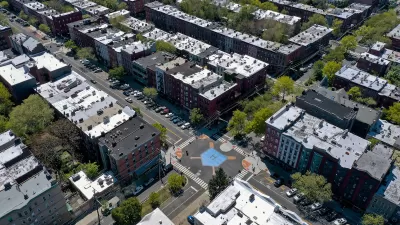We can best thank Portland and other pioneers for all their hard work with on-street bicycle parking (a.k.a. "bike corrals") by simply benefitting ourselves from their efforts. Here's how...
Early questions about traffic laws, safety, and practicality have been vetted through several versions of the so-called "bike corral", now in use across the country such as in New York City, Chicago, Los Angeles, Seattle. Nowadays just about anyone with a few hundred bucks can install one with little fuss.

Bike Corral in the 25 foot prohibited parking zone at Washington and Third Streets, Hoboken, NJ
In 2012, walk- and bike-friendly Hoboken, New Jersey joined the growing ranks of bike-corralled cities when it was fortunate enough to receive a $5,000 grant from the Bikes Belong Coalition for two pilot demonstrations in a city where every inch of on-street parking is at a politically-perilous premium. Below is a summary of best practices and lessons learned in Hoboken's first implementations for other municipalities interested in following suit.
-
Capitalize on street "dead space":
New Jersey has a fantastic pedestrian safety law that forbids parking at intersections within 25 feet of a crosswalk. The intent of the law is to improve line-of-sight visibility between motorists approaching intersections from crossing streets, as well as with pedestrians entering crosswalks. Combined with New Jersey's "driver must stop for pedestrians in crosswalk" law, pedestrian safety is better guarded here than most places. Many states do not have a similar law, but keeping those first few feet clear of solid objects (like parked cars) above the driver's sight level (Traffic engineers suggest 3.5 feet to be the threshold height for visual obstructions) is nonetheless helpful to improving pedestrian safety in urban areas.Bicycle corrals are an excellent way to maximize the use of this area (so are rain gardens); in Hoboken, where parking in these zones is prohibited, it makes perfect sense to use bicycle corrals to get the most out of every square inch of public space. Taking bicycle parking off sidewalks and placing it in dead spaces on-street is doubly beneficial and typically an easy conversation to have with (most, but not all) motorists.
There are other dead street spaces that can benefit from the placement of bike corrals as opposed to being used for illegal parking and other activities detrimental to traffic and pedestrian safety. Hoboken's first major bike corral was strategically located at the top of a "T" intersection just a block away from the epicenter of commuter activity in the city, Hoboken Terminal. The location choice was in response to the urelenting demand for more and more bicycle parking in this area, as well as to "extend the perceived area" of the transit facility further west to what was previously an ignored and underutilized stretch of chainlink fence-lined street. The use of this area for more pedestrian and bicycle activity, as well as the adjacent placement of a local shuttle bus stop, has slowed down speeding traffic and brought a desolate snippet of the city into the fold of its bustling multi-modal transportation center. But most importantly, the placement of a bike corral at this location physically prevented illegal parking of delivery vehicles and private autos that regularly interrupted the line-of-sight between drivers and pedestrians at one of the city's most heavily trafficked crosswalks.

Illegal parking between two heavily trafficked crosswalks was eliminated with the installation of a bike corral at Hudson Street & Hudson Place - Bolt down, and firmly:
Hoboken's first attempt at installing a bike corral had a few hiccups, or two to be more precise. First, there was little coordination in advance with the adjacent business owners. Second, the racks were individually anchored to the pavement in such a way that people "leaning" on them could leverage the bolts out of the asphalt and topple the racks. Although conversations after the installation resulted in an understanding of the purpose and value of the infrastructure, the initial reactions about the loss of a de facto loading zone as well as the perception that the bicycle corral was meant to discourage customers from nearby businesses were negative and detrimental to getting the program off the ground (or, sorry, in the ground, ugh!).Structurally, Hoboken resolved this by adopting a "rack & rail" system, whereby two metal rails are anchored firmly and flush to the pavement, and the legs of the racks are then individually bolted to either rail, creating a system that is tremendously sturdier than the original method and also easier for crews to install. These systems can be self-designed by municipal garage staff with a few off-the-shelf parts, or bought as street-proven kits from a few manufacturers with excellent track records. Either way, this is the best and most cost-effective method for securing a row of bicycle parking on pavement.
- Partner with local businesses for maintenance, activity, and support:
Hoboken has had a successful bicycle parking and repair station sponsorship program in place for several years, allowing both businesses and private residents to sponsor the cost and maintenance of bicycle parking in specified locations that may not necessarily be in the city's immediate schedule. Adding bike corrals to this sponsorship program was an intuitive next step and comes with many benefits.Foremost, a sponsor who agrees to the cost and basic upkeep of the corral guarantees a local champion is there to not only promote the location but protect it from marauding ne'er-do-wells who have a seemingly late-night penchant for exploring the physical resilience of city infrastructure. Sponsorship commits the adjacent business to keeping the space free of litter and snow (which are legitimate and often-heard maintenance concerns voiced by opponents or critics of the program), and ensures that damage or misuse gets reported to city officials quickly.
Partnership also stimulates adjacent businesses to adopt or expand their bicycle delivery activities – or encourages employees to commute to work by bicycle – and folds the new infrastructure into the day to day business operations of the block. These are all valuable benefits that bolster the permanence of a fledgling program.
- Communicate bike corrals' contribution to pedestrian safety:
Talking about the purpose and benefits of bike corrals should arguably start with their contribution to safety, which is generally an all-around positive-reaction conversation. It's great to take it further than that, but safety is a global concern. Sure, bike corrals encourage bicycling, thereby reducing vehicular traffic, and yes they are catchy for telling your city's "progressive" story to visitors, but positioning bike corrals as part of a city's safety improvements is a bigger winner in mixed public discussions. Leaving some of the more technical benefits that are attractive to planners for more focused conversations - or as supporting documentation in materials for distribution - subjects advocates to less up-front opposition. - Use configurations that encourage safer riding:
There are plenty of configurations and good design manuals out there, but the fundamental goal is to minimize exposure of riders to vehicular traffic and make the bike corral visible and obvious. Hoboken has adopted a configuration that places the bicycles closer to the travel lane, encouraging bicycle riders to mount/dismount their bikes on the curb-side of the corral. The angled position encourages a one-way flow of bicycle riding (entrance further from the intersection to, exit closer to the intersection where traffic signal stop bars and crosswalks are easily reached in clear view of drivers.)Each aspect of the configuration described above contributes to improving the overall safety and integration of the bike corral with other traffic infrastructure. The configuration also includes standard pavement markings, striping, and USDOT-approved vertical delineators (plastic poles) at the thresholds between the travel and parking lanes. These materials are standard to any municipal road crew and installation is easy to explain.
- Don't be afraid to try new locations:
Sponsorship means that the community may request bike corrals in locations that are not currently targeted for increased ridership. Hoboken's installation on Washington and Third streets did not initially seem like the most obvious place to install one of the city's first bike corrals, but nowadays that location is usually full of bikes and clearly shows how placement of additional bicycle parking can induce demand, whether by simply broadcasting the idea that bicycling is a possible modal choice, or by making it easier for people to ride to that area of the city. - Call it "bicycle parking" not "bike racks":
Bicycle parking is not street furniture, it is a serious component of a city's parking infrastructure, and therefore its transportation demand management plan. If bicycle parking is being funded through the same municipal budget line items as benches, tree pits, and trash cans, then it's not getting the respect it deserves. Municipalities can start prioritizing the necessity of bicycle parking by not calling this equipment bike racks, and the next step should be to fund bicycle parking from the same budget and revenue stream as other parking infrastructure (i.e. meters, signs, gates, doors, garages, etc.) This is not just important on principle, it shifts the cost burden to the department that benefits most from increased bicycle use in a city; that is, the parking authority that is attempting to manage not just parking supply but also demand.

Pennsylvania Mall Conversion Bill Passes House
If passed, the bill would promote the adaptive reuse of defunct commercial buildings.

Planning for Accessibility: Proximity is More Important than Mobility
Accessibility-based planning minimizes the distance that people must travel to reach desired services and activities. Measured this way, increased density can provide more total benefits than increased speeds.

World's Largest Wildlife Overpass In the Works in Los Angeles County
Caltrans will soon close half of the 101 Freeway in order to continue construction of the Wallis Annenberg Wildlife Crossing near Agoura Hills in Los Angeles County.

Eviction Looms for Low-Income Tenants as Rent Debt Rises
Nonprofit housing operators across the country face almost $10 billion in rent debt.

Brightline West Breaks Ground
The high-speed rail line will link Las Vegas and the Los Angeles area.

Colorado Bans No-Fault Evictions
In most cases, landlords must provide a just cause for evicting tenants.
City of Costa Mesa
Licking County
Barrett Planning Group LLC
HUD's Office of Policy Development and Research
Mpact Transit + Community
HUD's Office of Policy Development and Research
Tufts University, Department of Urban and Environmental Policy & Planning
City of Universal City TX
ULI Northwest Arkansas
Write for Planetizen
Urban Design for Planners 1: Software Tools
This six-course series explores essential urban design concepts using open source software and equips planners with the tools they need to participate fully in the urban design process.
Planning for Universal Design
Learn the tools for implementing Universal Design in planning regulations.


























